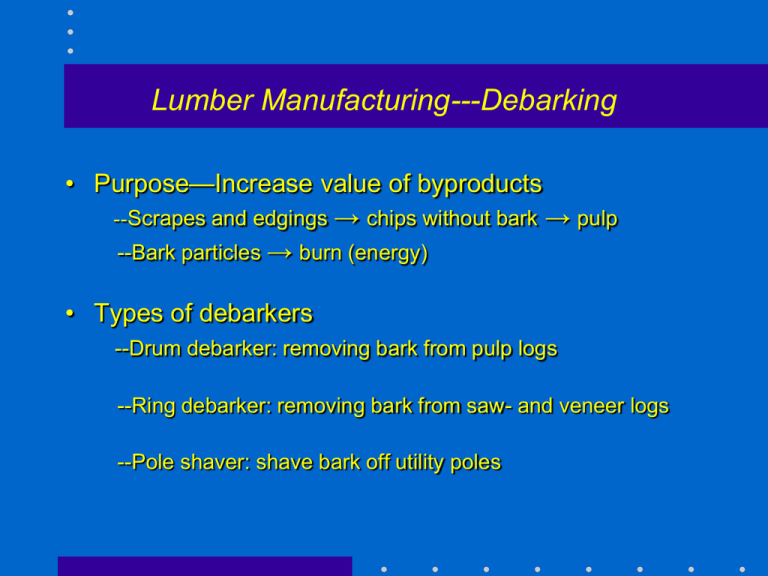Lumber Manufacturing I
advertisement

Lumber Manufacturing---Debarking • Purpose—Increase value of byproducts --Scrapes and edgings → chips without bark → pulp --Bark particles → burn (energy) • Types of debarkers --Drum debarker: removing bark from pulp logs --Ring debarker: removing bark from saw- and veneer logs --Pole shaver: shave bark off utility poles Drum Debarker • To remove bark from pulp logs Corrugated interior tumbles the logs and scrapes off bark; logs rub against each other to knock off bark; water shower softens bark and washes bark out of the drum. Because of gentle rubbing action very little removal of quality fibers from surfaces. Ring Debarker • To remove bark from saw- and veneer-logs Logs are centered in a ring of rosser heads with projecting teeth; bark is removed with a pressure about 30 to 50 psi. Bark is removed at high speed with substantial surface removal of wood but does not affect lumber or veneer yield. Pole Shaver • To move bark from utility poles to obtain smooth surfaces Pole rotates as it passes under a floating peripheral-milling cutterhead, removing the bark with a minimum of wood loss and retaining the natural taper. Primary Breakdown—Head saws • Band saw: Able to handle large logs, provide straight cuts and thin saw kerf increase lumber yield. • Circular saw: Saw diameter limits log sizes, thick saw blades for stability (1/4”) large saw kerfs reduces lumber yield. Saw Mills • Scragg Mills Consists two or four circular saws on a common arbor. Distance between blades can be adjusted to produce 4-, 6-, or 8-inch cants. The logs are commonly moved through saws by a conveyor. • Multiple Band Mills Similar to scragg mills except that breakdown is done by 2 or more opposing bandsaws, producing two slabs and one cant if two bands are used. • Chipping Headrigs Logs pass through a set of side cutterheads to remove excess wood into chips, followed by another set of top/bottom cutterheads to produce a cant. Chips are to be used for pulp & paper. Chip-N-Saw Designed to process small straight Logs 6 to 16 inches in diameters. Logs first pass through two pairs side and top/bottom) chipping cutterheads to square or shape logs, followed by passing the cant through a series of circular saws mounted on a common arbor to produce multiple pieces lumber. High-Tech Mills • BOF (Best Opening Face) For high efficiency: Electronic hardware (scanner & computer) and good computer software; machine that is able to position logs quickly & saw accurately with thin kerf. Resawing • Ripping—Ripping is to saw lumber along the grain. Slabs produced by headrigs are cut with a pair of circular saws (called an edger) to square the edges to a specific width simultaneously. Large slabs are rip into multiple pieces with a series of circular saws mounted on a common arbor (gang saws). • Rough trimming—Trimming is to saw lumber across the grain to a specific length. Rough trimming follows the ripping to cut green lumber into pre-determined lengths, usually done with a pair of hollow ground circular saws. Sorting & Drying • Sorting—This operation is to sort cut lumber into different grades, species or species groups, thickness, length and sometimes according to moisture content. • Drying (seasoning) --Reasons to dry : Seasoned wood is dimensionally stable Dry wood is durable against inscets & decay Dry is stronger --Air-dried lumber: moisture content >15% ≤19% --Kiln-dried lumber: moisture content ≤15%






